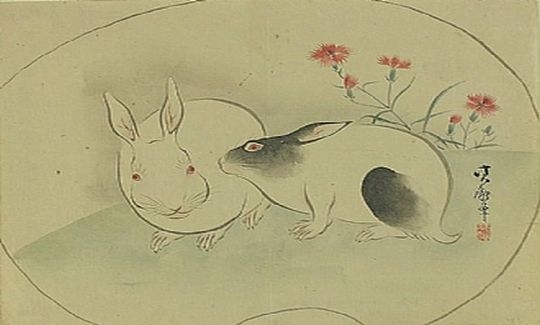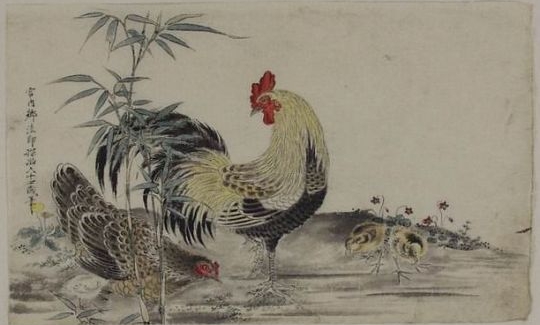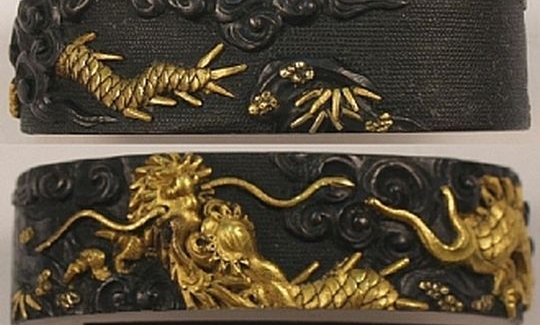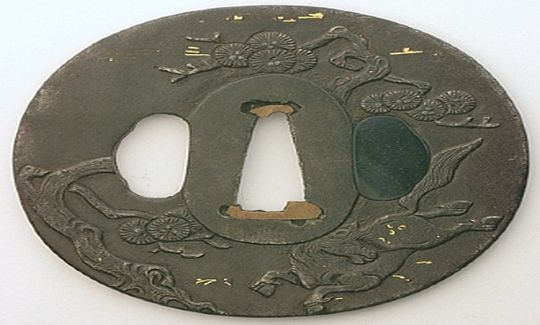There is a legend that before Buddha entered nirvana, he summoned every living creature to him. Twelve creatures presented themselves, in the following order: mouse, ox, tiger, hare, dragon, snake, horse, sheep or ram, monkey, cock, dog, and a wild boar. As an expression of his gratitude, Buddha decided to name the years for them, according to the order of their arrival. As in this fable, the Chinese calendar is divided into twelve-year cycles, each of which is named for one of these creatures.
In the year 604, the Japanese empress Suiko (593-628) adopted the Chinese calendar, which is known as the sexagenary (i.e. 60-year) cycle (in Japanese: Eto). It is an ancient system of counting hours, days, months, years and directions, based on the twelve lunar months and a leap year with thirteen months. This system has two orders of signs - one of ten signs known as the "ten stems", and the other of twelve signs, the "twelve branches" (Jikkan Junishi). Conjunctions of the signs from both systems create a cycle of sixty pairs, each pair representing a year. After sixty years, the cycle of ten stems is completed, as are five of the branches, and a new cycle commences. This is why great importance is attached to a sixtieth birthday, when a person completes a calendar cycle, and returns to the original conjunction of signs of the year of his/her birth.
In China, a tortoise shell carved with these signs was found during the excavation of an archaeological site from the Yan era (ca. 1100 BCE). Some believe that the ten stems were originally intended for counting days (in three groups of ten), and the twelve branches were used for the months and years. Ultimately, the two systems were unified to form the sexagenary cycle, and in the first half of the Late Han period (25 - 222 CE), the same system was adopted for hours, days, months, years, and directions. They also began to use the twelve branches for the hours of the day (each ‘hour' being equivalent to about two hours of our time), combining the ten stems, based on the yin-yang values (complementary opposites), and the five elements - wood, fire, earth, metal, and water - to establish both the days and directions of good and evil influences. During the Late Han era, they began depicting these twelve branches according to the creatures in Buddha's story. This may have been influenced by Hellenistic astrology, brought to China by way of India. As a result, the system was widely used for foretelling the future, as it was in western astrology.
Predicting the future, which reached Japan together with the symbols for the ten stems and twelve branches, employed the "twelve clocks" system (Junichoku), which was in use during the Asuka period (second half of the 6th century - 710). The "twelve clocks" was a series of values, such as fulfillment, failure, control, disorder, etc., used to assess the quality of the days. Such beliefs were popular, especially in the Edo era (1603-1868), when people tried to decide which times were most propitious (and which were not), prior to any event such as opening a new enterprise, or getting married.
As in the West today, in China and Japan they believe that character is derived from the birth sign. For example: all those born in the year of the mouse are restless; children born under the sign of the ox are patient. Female children born during the "hinoe uma" the year of fire, (the basis for the yang and the horse), which is the forty-third year of the sixty-year cycle, are considered in Japan to be particularly stubborn, and fatal to their husbands. These women have difficulty in finding husbands, and many baby girls born in the year of the fire were murdered. The year is also thought to be particularly prone to fires. Another belief is connected with the sign of the dog. In the past, on the day of the dog, pregnant women wore a sort of leash round their bellies, to help them to support the foetus, perhaps because the dog is thought to be the protector of babies. Again, since it is not polite to ask the age of a Japanese person, one usually asks what is their luck sign, from which their age can later be deduced.
Koshin is the day or the year in which the ko - associated with metals and the planet Venus - comes together with shin - the sign of the monkey, the ninth sign in the calendar. According to ancient Taoist tradition, on the night of koshin, the three worms which live in a man's body emerge and tell the deities about his sins, as a result of which the gods may curtail his life. For fear that this might happen, people were accustomed to stay awake all night.
In 1873, the Meiji rulers substituted the Gregorian for the lunar calendar, but for many years the Japanese continued to abide by the latter. In 1945, for instance, 60% of the Japanese farmers were still using it. Even today, many festivals take place on auspicious dates derived from the lunar calendar. The New Year and the Spring Festival (Risshun) are still celebrated at the beginning of February.
In China and in Japan there are many fables and legends about the twelve creatures representing the years, months, hours and directions, and they frequently appear in Japanese art - on inro boxes (little containers usually covered with lacquer), in netsuke carvings, which are attached to the inro by cords, on sword accessories, and in coloured woodblock prints and paintings. Especially renowned are the painted scrolls of Kano Korenobu (1754-1809) and Sosen Mori (1749-1821), the coloured woodblock prints of Ando Hiroshige (1797-1809), and the series of signs of the zodiac and the twelve selected Japanese heroes by Utagawa Kuniyoshi (1798-1861).




